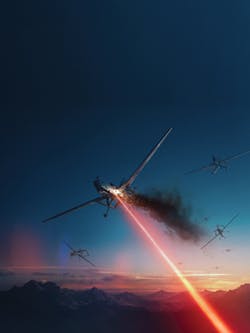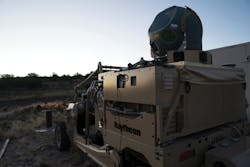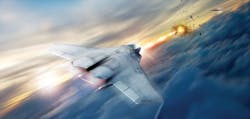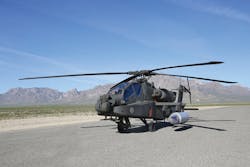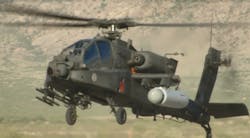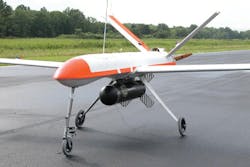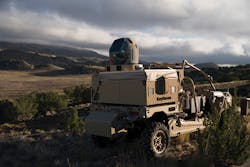From surface warships, jet fighter aircraft, military tactical vehicles, and even unmanned systems, laser weapons are demonstrating with increasing frequency that they are ready for the battlefield
By J.R. Wilson
The 21st Century already has seen more “science fiction” become everyday fact than at any other time in history, from smart phones that make Star Trek’s communicators appear primitive to the Robonaut — a C3P0-like humanoid robot working on the International Space Station — to perhaps the most iconic of all: laser weapons.
Directed-energy weapons (DEWs) have been a staple of future warfare depictions since H.G. Wells published “War of the Worlds,” with its Martian “heat rays,” 120 years ago. Hughes Aircraft engineer and physicist Theodore Harold Maimain generally is credited with inventing the laser, firing the world’s first coherent light — in-phase rays of the same wavelength — from his solid-state pink ruby laser on 16 May 1960.
Progress from that point moved steadily forward technologically, but lasers found little support from military leaders, who saw them as little more than weak, short-range toys. One of the first large-scale productions of lasers actually was in toys, along with laser pointers. As they became stronger, with longer ranges, the military began using laser beams to illuminate targets; warfighters on the ground or aboard helicopters would focus a beam on a target, and a rocket, typically fired from a second platform, would follow the beam to the target.
Laser-guided weapons improved significantly during the long post-9/11 wars in Iraq and Afghanistan, becoming part of the U.S. military’s arsenal of precision guided weapons that greatly reduced collateral damage to property and non-combatants. Experiments continue to expand the way in which lasers are and will be used by the military, such as recharging unmanned aerial vehicles (UAVs) in flight.
Disabling battle tanks
Weapons that could halt enemy tanks and infantry or bring down hostile UAVs, bomb-carrying balloons, or manned aircraft, disable satellites, or destroy missiles in flight remain a top goal — and one that already has been demonstrated and almost certainly will see widespread military deployment by the 2020s. How soon they will become an integral and significant part of U.S. military capability “is a customer-driven decision,” Ron Dauk, a program manager for laser and electro-optical systems at the Boeing Co. Directed Energy Systems segment in Albuquerque, N.M.
“We are starting to see customers purchase multiple laser weapons systems and move toward how to integrate those into standard deployed combat forces. So I would say that time frame is sooner rather than later, perhaps even this year, Dauk says. “The technologies and capabilities are relative enough to demonstrate that, as we have with the Stryker system in Germany in recent months. So I think it’s coming pretty soon,” he says.
Fast-moving laser weapons like this prototype mounted to a light tactical military vehicle depend on reducing component size, weight, and power consumption (SWaP).
Some of the near-term pushes in deployable laser weapons are in ground and naval applications, which is probably where laser weapons will first cross the threshold to be deployed, Dauk says. “There is more of a challenge in airborne systems that can operate effectively within the constraints of an airborne platform. So the Army and Navy probably will be the first, but with the Air Force not far behind.”
With all the services working on laser weapons, he adds, the near term will see several new opportunities to bring unique capabilities to the battlefield, to engage targets very cost-effectively, and meet the need for a mix of various responses and capabilities. “They provide a great solution to shooting down a $600 quad-copter with a dollar-a-shot laser,” Dauk says.
The ability to bring lasers to all kinds of high-level applications probably will happen between 2025 and 2035, Dauk says. “We’re looking at how to bring lasers to all kinds of higher-level applications, such as ship defense for airborne self-protection,” Dauk says. “Lasers can provide solutions to some very hard targets right now — and with the technology increasing and developing, they really are becoming a viable option, to the point where the military can seriously consider a laser weapons system in their mix of capabilities.”
Won’t replace kinetic weapons
Rhoan Boucher, directed energy lead for Boeing’s Integrated Air and Missile Defense, is quick to note laser weapons, despite rapid technological evolution and unique capabilities, will not replace existing or future kinetic weapons in the foreseeable future.
“We view lasers as complementary to current systems, not competitive. It allows field commanders to dial an effect. They want the option to be able to decide what the best mix is to go after a particular target and lasers will increase those options, today and in the future, while keeping costs low,” he says.
The Army Space and Missile Defense Command (SMDC) at Redstone, Arsenal, Ala., is in charge of meeting requirements for lasers in missile defense for Army UAVs and helicopters, and for ground troops and vehicles. The Army is looking at several potential laser weapon systems, platforms and use strategies, including enhancing the maneuver force with adjustable non-lethal-to-lethal lasers mounted on combat vehicles.
One of those efforts demonstrated arming a Stryker combat vehicle with a 5-kilowatt Mobile Expeditionary High-Energy Laser (MEHEL), which completed a hard-kill challenge at White Sands Missile Range, N.M., before going to Fort Sill, Okla., where regular soldiers began testing it, says Lt. Gen. James Dickinson, commander of Army Space and Missile Defense Command.
Significant milestone
The next challenge is to install a 100-kilowatt laser on a Family of Medium Tactical Vehicles (FMTV) truck to provide laser weapons for brigade combat teams. Those programs and others mark a significant milestone in the history of laser weapons.
“These are no longer lab systems. They are being built and taken out into the field or being readied for deployment. We’re no longer talking about the art of the possible,” says Rob Afzal, senior fellow-laser and sensor systems at Lockheed Martin Rotary and Missions Systems. “We’re just at the beginning and these systems will evolve to more power from the laser, more capability from the sensors and continuing reduction in SWaP [size, weight and power], so they can be more capable on more platforms.”
Laser weapons offer several advantages, Afzal says. “Its importance, is two-fold: great precision with low collateral damage and, second, the cost-exchange ratio. If the operation of the system is very low-cost, once installed, being able to use it in an asymmetric way against other low-cost threats will play a very important role.”
Laser weapons are moving out of the laboratory and into the field at a quickening pace. “We’re focused on moving laser weapons systems out of the lab and onto the battlefield to give our warfighters a decisive advantage,” says Ben Allison, high-energy laser product line director of advanced concepts and technology at Raytheon Space and Airborne Systems in El Segundo, Calif.
“With that goal in mind, we’re investing in ready-now capabilities and near-term technologies,” he says. “For example, we’ve put the MTS [Multi-spectral Targeting System] at the center of our solution. With more than 4 million combat hours, it’s a proven sensor with unmatched detection and tracking capabilities. We’re coupling MTS with mature, fiber-combined lasers and demonstrating our capabilities in real-world scenarios.
Raytheon demonstrated the company’s High-Energy Laser Weapon System (HELWS) late last year at the Army’s Maneuver Fires Integrated Experiment at Fort Sill, Okla., aboard a Polaris MRZR small all-terrain vehicle. The system identified, tracked, fired on, and destroyed a mix of 12 small- and medium-sized UAVs. Company officials also worked with separate Army organizations to demonstrate the HELWS on the AH-64 Apache attack helicopter.
Parts of a system
Allison notes the laser itself is only one component of a laser weapons system. “The laser is just part of the solution. The beam director, power and thermal systems are equally important components. State-of-the-art for HEL is about the art of the possible. It comes down to how you make the subsystems — beam directing, power, and thermal — work together to create an integrated solution. Optimization is the key,” he says, adding creating such an optimized and integrated solution opens the door for lasers in a wide range of applications.”
Almost every military platform considered appropriate for laser weapons is under consideration for HELWS, Allison says. Some examples include the Navy and U.S. Marine Corps Humvee, the Army the Stryker and FMTV, and the army and U.S. Special Operations Command (SOCOM) AH-64 attack helicopter and MH-60 utility helicopter.
The U.S. Air Force Self-protect High Energy Laser Demonstrator (SHiELD) program seeks to integrate a high-energy laser onto a tactical aircraft for self-protection against incoming threats.
Also under consideration for laser weapons is the MRZR light tactical vehicle for rapid deployment, the F-15 jet fighter for the Air Force Research Laboratory’s Self-protect High Energy Laser Demonstrator (SHiELD) program, and the AC-130 utility turboprop aircraft. “Fixed installations for area protection also are important,” Allison says.
The U.S. Air Force has long pushed the boundaries of laser and support technologies, seeking ways to integrate a high-energy laser and the power and cooling systems they require into the already densely packed spaces in military aircraft, especially jet fighters.
Air Force aircraft and spacecraft also share responsibility for missile defense. The Air Force directed-energy weapons flight plan systems in development are to deliver effects against adversary systems and not directly against humans.
The Air Force Research Laboratory (AFRL) Directed Energy Directorate at Kirtland Air Force Base, N.M., is overseeing several laser weapon efforts, yet its SHiELD project is the science and technology priority. SHiELD’s goal is to integrate a high-energy laser system onto a tactical aircraft to demonstrate self-protection against incoming threats.
Laser systems have been integrated into several ground and sea military platforms like the Army’s HEL-MD demonstrator and the Navy’s Laser Weapon System (LaWS), as well as large aircraft like the Airborne Laser [ABL] and the Advanced Tactical Laser.
Size, weight, and power
“SHiELD will take these advances one step further in reducing size and weight and ruggedizing the system for use on a tactical aircraft,” says Michael Jirjis, directed energy experimentation lead at the Air Force Research Lab.
“The Air Force is also pushing money to other efforts not within AFRL, examining options to use some directed energy prototyping funding on an AC-130 gunship and to support the high-value aircraft defensive mission set,” Jirjis says.
The Air Force Strategy document — “America’s Air Force: A Call to the Future” — calls directed energy a “game-changing” technology offering transformational capabilities to airmen, enabling them to “effectively, affordably and rapidly defeat massed attacks from an adversary and to strike critical targets at the speed of light,” according to the Air Force directed-energy weapons flight plan.
Raytheon is working with U.S. Special Operations Command to fire a directed energy beam onto a ground target from the AH-64 Apache attack helicopter, shown above, as well as from other military helicopters.
“These same weapons can provide the ability to precisely engage targets of interest with little to no collateral impacts or detectable disturbance and provide protection to Air Force assets that must operate in harm’s way. directed-energy weapons provide flexibility by offering an increased range of effects when used in conjunction with conventional weapons. The range of effects include destroy, damage, disable or disrupt and the effects can be permanent, temporary or reversible,” the Flight Plan states.
While great strides have been made in the past few years, the next generation of laser weapons will need advancements in several areas to make such systems more operationally viable against a larger number of targets, Allison says. Those areas include high-density power systems based on lithium battery technology; sensors and tracking; advanced RF systems; laser power from tens to hundreds of kilowatts, depending on the mission; and all laser ranges from base defense near-range to long ranges for advanced capabilities.
“Advanced algorithms and computing contribute to a more capable target track system, providing for quicker, more precise and more efficient engagements, says the Air Force Research Lab’s Jirjis. “The power and thermal management system directly impacts the rate at which you can fire and recharge the high-energy laser. Advanced optics provide greater sensor and effector capability in a variety of conditions.”
Lasers aren’t just all about weapons. “Airborne high-energy laser systems will be used as hybrid sensors and effectors for certain target sets in the near future,” Jirjis says. “Lasers may ensure aircraft survivability and defend against long-range threats. Ground-based high-energy laser systems will soon become a limited — but key — part of the Air Defense network. Eventually, they may even replace some certain kinetic air defense systems. The Navy has already fielded demonstrators on ships and is aggressively driving development and fielding more advanced systems.”
Raytheon is demonstrating a prototype high-energy laser weapon for its suitability for tactical aircraft like the AH-64 Apache attack helicopter, shown above.
Busy laser activity
The past year has seen a significant level of activity and program advancements in laser weapons, says Lockheed Martin’s Afzal. The first program that Lockheed Martin won was Laser Advancements for Next-generation Compact Environments (LANCE), an Air Force Research Lab to build a high-power laser.
LANCE is part of a larger program called SHIELD, which is a demonstration to put laser weapon into a pod, Afzal says. The company also won the next phase of the Army High-Energy Laser Tactical Vehicle Demonstrator (HELTVD) program to put a laser on a military truck.
“The biggest award of that period was from the Navy for the High Energy Laser and Integrated Optical-dazzler with Surveillance [HELIOS], to build and deliver a complete laser weapon for integration onto a destroyer. Its function is to engage and destroy UAVs and small boats. It also has a non-lethal optical dazzling capability over long distances to dazzle surveillance sensors,” Afzal says.
Where the world is headed with laser weapons is part of discussions within each armed service and collectively across the U.S. Department of Defense, U.S. allies, and potential adversaries. Discussions range across applications, from short-range, low-power, and non-lethal to high-energy lasers capable of destroying a ballistic missile in flight.
Lockheed Martin has demonstrated the company’s Advanced Test High Energy Asset (ATHENA) laser against medium-sized UAVs like the MQM-170C G2 Outlaw, shown above.
“Across all our military services and agencies, everyone has some type of technology demonstration or prototype under development,” says Paul Shattuck, director of directed energy systems at Lockheed Martin Space Systems in Sunnyvale, Calif. This has led to major acquisitions and programs of record, he says.
Lockheed Martin’s Advanced Test High Energy Asset system, also known as ATHENA, is a prototype laser weapon system designed to defeat close-in, low-value threats like rockets, UAVs, and small boats. It is a transportable, ground-based system that serves as a low-cost test bed for demonstrating military laser weapons technologies. A ruggedized variant of the system would be suitable for military operations.
“ATHENA is a complete, self-contained laser weapon system designed primarily for tactical operations, such as defending forward bases against rockets, artillery, UAVs,” Shattuck says. ATHENA has been in operation since 2012, and this past year was 5-for-5 in tests against the MQM-170C G2 Outlaw medium-size UAV from Griffon Aerospace in Madison, Ala.
In the Fall of 2017, the Missile Defense Agency (MDA) in Huntsville, Ala., awarded contracts to Lockheed Martin, General Atomics, and Boeing to develop preliminary designs for the Low Power Laser Demonstrator (LPLD), concluding two years of concept designs. During Phase 3, tentatively scheduled for 2019 through 2023, one or more of those designs will be built and flight-tested to demonstrate the ability to acquire a missile in flight and hold the laser beam steadily on-target.
The role of artificial intelligence
The question of whether artificial intelligence may be relevant for laser weapons hovers over the technology. “As multiple asymmetric threats become more prevalent, AI could play a significant role in detection, targeting and aim point selection and maintenance,” says Raytheon’s Allison.
Many grades of artificial intelligence exist today for target detection, identification, and tracking, yet in the near future a human always will be involved in the process.
Raytheon is demonstrating the feasibility of designing mobile laser weapons mounted to light tactical vehicles to protect warfighters and equipment on the front line from unmanned aircraft, rockets, mortars, and artillery shells.
“In next-generation systems, you’ll see more intelligence added into the laser weapon, especially as new intelligence and targets come on line,” Allison says. “As you add in continuing improvements in targets, laser weapons will be integrated into larger systems of systems and a layered type of defensive system, with various sensors fused together and tasking of weapons depending on who has the highest possibility of prosecuting the mission.”
Determining how these weapons will function in the real world will play an important role. “As you get these into the field, it’s really learning their capabilities, probably finding things you didn’t expect that will open up new avenues for offensive and defensive operations and rules of engagement — and that’s when they really come into their own,” Allison says.
Lasers won’t replace legacy weapons
There is general agreement across the military that laser weapons will not replace legacy nor future new kinetic systems, but will become a significant and integral part of a new offensive and defensive, lethal and non-lethal, increasingly accurate, flexible, multi-platform weapons system-of-systems.
Unlike the past four decades, however, the U.S. will not be alone in this evolution and is certain to face peer and near-peer adversaries who are pouring more and more resources into developing and quickly fielding weapons that will change the face of warfare.
“We can no longer rely on superior numbers of weapons and must leverage disruptive technologies to increase the effectiveness of our weapons. Although directed energy weapons cannot replace kinetic capabilities, they have the potential to become powerful new force-multipliers and greatly reduce the overall cost of conducting key U.S. offensive and defensive operations,” predicts the Air Force Research Lab’s Jirjis.
“In particular, a combination of non-kinetic and kinetic systems could enable U.S. forces to prevail more rapidly over enemies fielding sophisticated anti-access/aerial denial weapons,” Jirjis says. “Lasers and High-Power Microwaves are being explored to offer transformational capabilities in combat scenarios to ensure our airmen the highest protection in an ever-increasingly dangerous environment.”
